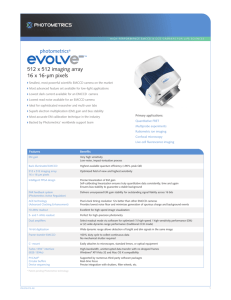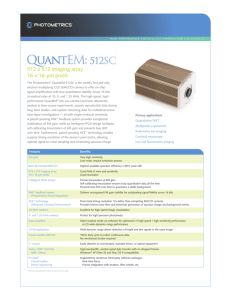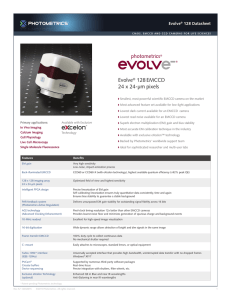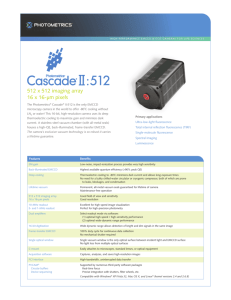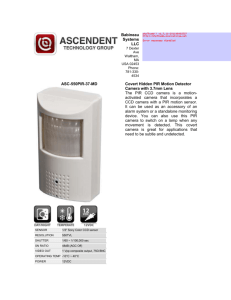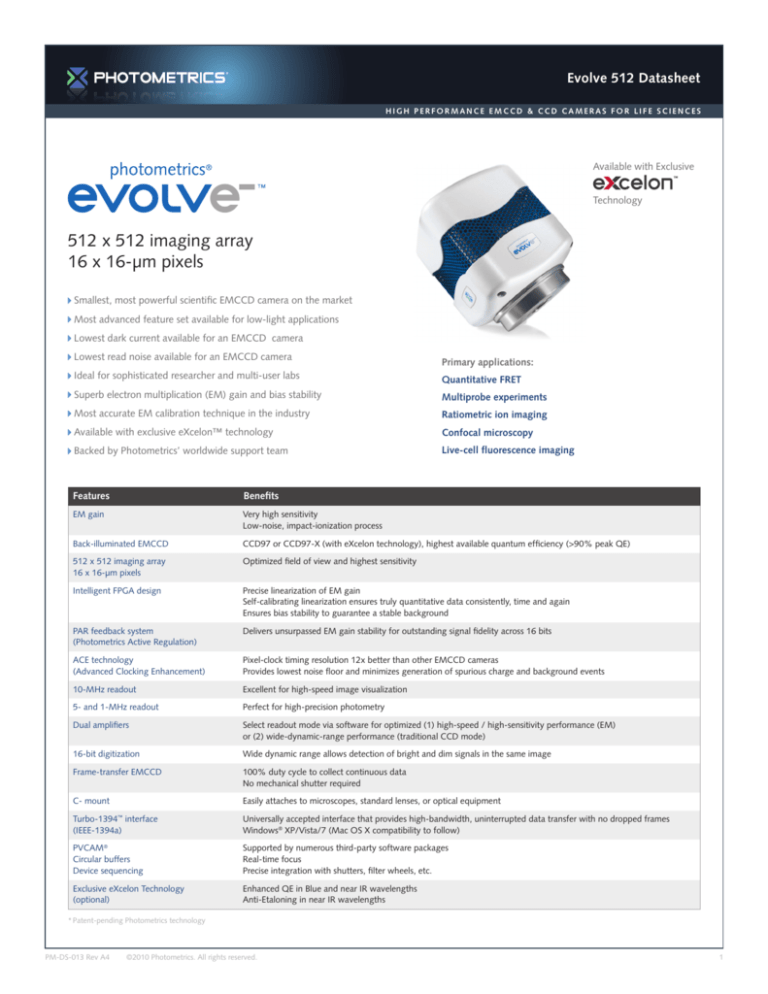
Evolve 512 Datasheet
HIGH PERFORMANCE EMCCD & CCD CAMERAS FOR LIFE SCIENCES
Available with Exclusive
Technology
512 x 512 imaging array
16 x 16-μm pixels
Smallest, most powerful scientific EMCCD camera on the market
Most advanced feature set available for low-light applications
Lowest dark current available for an EMCCD camera
Lowest read noise available for an EMCCD camera
Primary applications:
Ideal for sophisticated researcher and multi-user labs
Quantitative FRET
Superb electron multiplication (EM) gain and bias stability
Multiprobe experiments
Most accurate EM calibration technique in the industry
Ratiometric ion imaging
Available with exclusive eXcelon™ technology
Confocal microscopy
Backed by Photometrics’ worldwide support team
Live-cell fluorescence imaging
Features
Benefits
EM gain
Very high sensitivity
Low-noise, impact-ionization process
Back-illuminated EMCCD
CCD97 or CCD97-X (with eXcelon technology), highest available quantum efficiency (>90% peak QE)
512 x 512 imaging array
16 x 16-μm pixels
Optimized field of view and highest sensitivity
Intelligent FPGA design
Precise linearization of EM gain
Self-calibrating linearization ensures truly quantitative data consistently, time and again
Ensures bias stability to guarantee a stable background
PAR feedback system
(Photometrics Active Regulation)
Delivers unsurpassed EM gain stability for outstanding signal fidelity across 16 bits
ACE technology
(Advanced Clocking Enhancement)
Pixel-clock timing resolution 12x better than other EMCCD cameras
Provides lowest noise floor and minimizes generation of spurious charge and background events
10-MHz readout
Excellent for high-speed image visualization
5- and 1-MHz readout
Perfect for high-precision photometry
Dual amplifiers
Select readout mode via software for optimized (1) high-speed / high-sensitivity performance (EM)
or (2) wide-dynamic-range performance (traditional CCD mode)
16-bit digitization
Wide dynamic range allows detection of bright and dim signals in the same image
Frame-transfer EMCCD
100% duty cycle to collect continuous data
No mechanical shutter required
C- mount
Easily attaches to microscopes, standard lenses, or optical equipment
Turbo-1394™ interface
(IEEE-1394a)
Universally accepted interface that provides high-bandwidth, uninterrupted data transfer with no dropped frames
Windows® XP/Vista/7 (Mac OS X compatibility to follow)
PVCAM®
Circular buffers
Device sequencing
Supported by numerous third-party software packages
Real-time focus
Precise integration with shutters, filter wheels, etc.
Exclusive eXcelon Technology
(optional)
Enhanced QE in Blue and near IR wavelengths
Anti-Etaloning in near IR wavelengths
*Patent-pending Photometrics technology
PM-DS-013 Rev A4
©2010 Photometrics. All rights reserved.
1
Superior Quantitative EMCCD Imaging
Photometrics Advanced Features
Features
Benefits
Quant-View
Allows camera to read out pixel values in terms of electrons measured, thereby enabling user to calculate
actual photon flux
™
Electrons-per-gray-level selector
Allows user to select how many electrons will cause a single gray-level increase in the image data, thus
permitting utilization of Quant-View while maintaining full dynamic range of EMCCD
Rapid-Cal™
3-minute EM calibration process is most accurate in industry; camera does not need to be detached from
microscope; no special attachments required; user-initiated
Background Event Reduction Technology™
Identifies pixels that are likely to contain spurious event data and then makes corrections, if desired
Black-Lock / Top-Lock
Intensity-filtering tool narrows visualization to the intensity range of the image features in which the user is
most interested
™
™
Vari-Bit™ selectable bit depth (8-16 bits)
Improves image quality by matching digitization bit depth to actual intrascene dynamic range
The Photometrics Evolve:512 is the ultimate deep-cooled, back-thinned EMCCD camera. Years of engineering expertise have enabled Photometrics to perfect every
element of the Evolve:512. The Evolve:512 offers life science researchers the world’s first advanced feature set designed specifically for EMCCD cameras and for
low-light-level bio-imaging applications. Each of the Evolve camera’s revolutionary features can easily be enabled or disabled by the camera user via software control.
This sophisticated functionality enhances the quantitative nature of the camera while simultaneously allowing researchers to concentrate on acquiring image data
relevant to their work.
Specifications
Read noise (e- rms @ Gain State 3)
10 MHz EM Port
5 MHz EM Port
5 MHz non-EM Port
1.25 MHz non-EM Port
45e32e12e6e-
Pixel Well Depth
Active area
Gain register
200,000e800,000e-
Bias stability
A measurement of the camera stability when no light hits the sensor.
A slope of zero would be ideal. See footnote #1.
Gain stability
A measurement of the stability of the electron multiplication applied to images.
Ideal value would be 0. The stability of the EM gain applied can be quantified by
measuring the slope of a sequence of images with known amount of light and EM
Gain applied. See footnote #2.
Field uniformity
The image quality of the EMCCD is assessed for gradients. A complete lack of any
gradient (i.e a flat image) would provide a numerical value of 1.00 See footnote #3.
≤0.0006 ADU/Frame
≤0.0012 ADU/Frame (@ 10MHz, 350X, Gain State 3, 20K ADU)
10 MHZ EM
5 MHz EM
5 MHz STD
1 MHz STD
Baseline bias value
500ADU but can be varied
Cooling temperature
Air cooled (@ ambient air 20˚C) - Standard
Chilled liquid (@ 0˚C) - Optional
Dark current
0.001 e-/pixel/sec (See footnote #4.)
Background events
(10 MHz, 1000X EM gain) Standard operation
(10 MHz, 1000X EM gain) BERT operation
0.0045 events/pixel (@ 1000X EM gain)
not detectable (See footnote #5.)
1.04
1.10
1.06
1.02
-85˚C
-100˚C
Relative charge transfer efficiency
Photometrics is able to measure this on each camera and optimize
this parameter.
Optimized on each camera (See footnote #6.)
Charge transfer efficiency
As specified by CCD manufacturer’s data sheet (See footnote #7.)
Dark signal non-uniformity (DSNU)
As specified by CCD manufacturer’s data sheet (See footnote #7.)
Photoresponse non-uniformity (PRNU)
As specified by CCD manufacturer’s data sheet (See footnote #7.)
Parallel shift rate
0.7 µsec. This is optimized with Charge Transfer Efficiency (CTE) and
CIC. Test results demonstrate that increasing parallel shift rate further can
decrease CTE and increase CIC, adversely affecting image quality and
sensitivity.
Note: Specifications are subject to change.
PM-DS-013 Rev A4
©2010 Photometrics. All rights reserved.
2
Superior Quantitative EMCCD Imaging
Bias Stability 10MHz Gain 3 350X
502
Read Noise vs. Slider Value
3.00
500
2.50
Noise e- (rms)
498
496
494
492
490
y = 0.0002x + 494.89
488
1.00
0.50
586
571
556
541
526
511
496
481
466
451
436
421
406
391
376
361
346
331
316
301
286
271
256
241
226
211
196
181
166
151
136
91
1.50
0.00
121
76
106
61
46
1
16
484
31
Series1
Linear (Series1)
486
2.00
1
101
201
301
1000
800
600
400
200
101
601
701
801
901
Region
Multiplication Gain vs. Slider Value
1200
1
501
Note: Actual data, not theoretical.
Binning
Actual Multiplication Gain (X)
Note: Actual data.
0.00
401
EM Slider Value
Frame Number
201
301
401
501
601
701
801
512 x 512
256 x 256
128 x 128
64 x 64
1x1
33.7
65.5
124
224
2x2
65.8
124.4
224
376
4x4
124
224
376
563
8x8
224
374.5
562
748
901
(Frames per second)
EM Slider Value
Note: Frame rates are measured at 10 MHz with 0-second exposure times.
Note: Actual data from camera.
Exclusive eXcelon Technology (optional)
600 nm
700 nm
800 nm
900 nm
Standard
Back-Illuminated
EMCCD
Quantum Efficiency Curve
100%
90%
80%
EMCCD
70%
60%
50%
40%
Reduced Etaloning
Up to 10 times lower etaloning in near IR
wavelengths compared to standard backilluminated sensors
Improved Sensitivity
Provides higher QE in the blue (<450nm) and
near IR (>700nm)
Exclusive Technology
Available on Evolve EMCCD Cameras
30%
20%
10%
0%
300
400
500
600
700
800
900
1000
1100
Wavelength (nm)
Standard Evolve
eXcelon Evolve
Liquid Cooled Evolve 512 EMCCD Camera (optional)
• Ideal for vibration-sensitive applications (eg. Atomic Force Microscopy)
• -85ºC with ambient liquid*
• -100ºC with 0ºC circulating liquid*
• Provides lowest possible dark current - 0.0003 e/p/sec
*Note: Use of Equipment not originally provided by Photometrics for use with Liquid Cooled Cameras will void any and all warranty coverage of the product. This is due to the specific
requirements of the cooling system and camera based on the type of liquid, liquid viscosity, flow rate, among other key factors to achieve the specified performance levels.
PM-DS-013 Rev A4
©2010 Photometrics. All rights reserved.
3
Superior Quantitative EMCCD Imaging
#1 Bias stability – The imaging stability of the EMCCD camera can be
2.56
assessed by measuring its output with no light falling on the sensor and
measuring the slope of the average intensity. The slope of the average
intensity value of a 200 frame sequence (where y=mx+b of the least
squares fit) is measured.
3.21
#2 Gain stability – The actual amount of EM Gain applied on each image in
a stream of images can vary depending on many electrical engineering
factors. The slope of the average intensity
2.56 value of a 200 frame
5.13
sequence (where y=mx+b of the least squares
fit) (@ 10MHz, 350X, GS
3, 20K ADU) is measured. An ideal value would be zero.
#3 Field uniformity – Specification was obtained using the following
formula: -σ(bias)/(σ(bias1-bias2)*.707) ≤ 1.15
2.56
8-32 TAPPED,
# 4 Dark current – This is measured in a traditional manner
with all CCD
0.125 (as
FU LL
cameras) by taking a long integration to2.875
obtain a signal.
TH REA DAn
; 4X.average
measurement is taken over the CCD area (excluding blemishes). It
should be noted that dark current can vary significantly between
different CCDs, and the numbers here are typical.
C C D C EN TERED TO
3.21
.63
+/- (2) PIXELS
FROM
# 5 Background events – As EMCCD
cameras
areCENTERLINE
actually capable of
detecting single photons, the real detection limit of these cameras is
set by the number of dark background events. These can arise from
two things, dark current (which is thermal generation of an electron
and is a temperature dependent phenomenon) and also clock induced
2.56
charge (CIC) electrons
(also called spurious charge). Each can lead to
the generation of non-photon derived electrons which are multiplied
through the electron-multiplication register, generating random high
value pixels which are above the read noise.
2.56
2.21
6.85
3.21
2.56
5.13 3.21
1/4-20 THREAD
T RI-POD MOUN T
CAN BE ATTACHED
ON AN Y OF TH E F OU R
SIDES BY REMOVING
LABE L.
2.56
2.875
8-32 TAPPED,
0.125 FU LL
TH REA D ; 4X.
2.56
CCD CENT ERED TO
+/- (2) PIXELS FROM CENTERLINE
These background events are measured by taking 30 ms exposure at
10MHz speed with 1000X EM Gain applied and counting the number
of random high value pixels which are at a single event threshold above
2.56
the modal value of the image histogram. This
number is expressed as
5.13
a probability of an event per pixel. The number can vary from frame to
frame and sensor to sensor; however, a typical value is provided.
#6 Relative CTE – Photometrics employs an unpublished trade secret way
of optimizing charge transfer efficiency. We have been doing this for
8-32 TAPPED,
years and are able to measure relative charge transfer
efficiency and
0.125 FU LL
actually tune each camera in order to 2.875
optimize this
parameter.
This
TH REA
D ; 4X.
ensures better optimal image performance.
#7 http://www.e2v.com/products/ccd-and-cmos-imaging-andsemiconductors/imaging-l3vision/datasheets-and-technical-papers.cfm
C C D C EN TERED TO
+/- (2) PIXELS FROM CENTERLINE
SPECIFICATIONS ARE TYPICAL AND SUBJECT TO CHANGE:
Photometrics
PVCAM
are registered
trademarks of Photometrics. ACE,
CAMERA
WIEGHT:
4.8 LBS.
• and
Background Event Reduction Technology, Black-Lock, Evolve, PAR, Quant-View,
Confidential and Proprietary, do not distrubute without
Rapid-Cal, explicit
Top-Lock
and from
Vari-Bit
are trademarks of Photometrics. Mac OS is a
premission
Photometrics.
trademark of Apple Computer, Inc., registered in the U.S. and other countries.
Windows is a registered trademark of Microsoft Corporation in the United States
and other countries. Other brand and product names are the trademarks or
registered trademarks of their respective owners and manufacturers. Product
photography ® 2008, Jay Ganaden Photography.
3.21
.63
2.21
2.21
6.85
1/4-20 THREAD
1/4-20 THREAD
TRI-P OD MOUNT
CAN BE ATTACHED
ON AN Y OF THE FOUR
SIDES BY REMOVING
LABE L.
T RI- POD MOUN T
CAN BE ATTACHED
ON A NY OF TH E F OU R
SIDES BY REMOVING
LABEL.
SPECIFICATIONS ARE TYPICAL AND SUBJECT TO CHANGE:
• CAMERA WIEGHT: 4.8 LBS.
USA 520.889.9933
Asia Pacific +65.6841.2094
PM-DS-013 Rev A4
France +33.1.60.86.03.65
Germany +49.89.660.779.3
Confidential and Proprietary, do not distrubute without
explicit premission from Photometrics.
©2010 Photometrics. All rights reserved.
SPECIFICATIONS ARE TYPICAL AND SUBJECT TO CHANGE:
Japan +81.3.5639.2731
www.photometrics.com
• CAMERA WIEGHT: 4.8 LBS.
UK +44.1628.890858
info@photometrics.com
Confidential and Proprietary, do not distrubute without
explicit premission from Photometrics.
4

